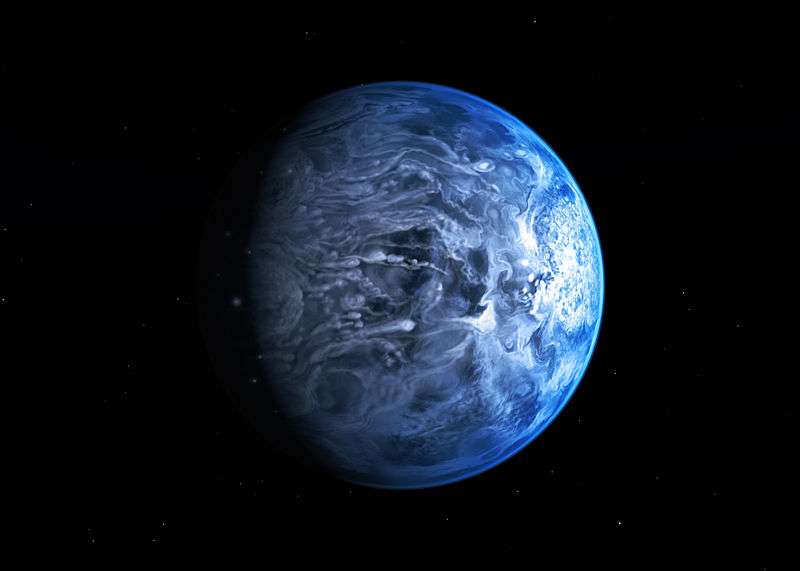April 6, 2016 report
Astronomers determine the structure and composition of clouds on a 'hot Jupiter' exoplanet

(Phys.org)—HD 189733b, located some 64 light years away, is the closest "hot Jupiter" exoplanet to Earth. Thanks to its proximity, it is a great target for atmospheric observations. Now, an international team of astronomers has presented a model of the planet's chemically complex gaseous layer, unveiling the structure and composition of mineral clouds in the atmosphere. The study was published Mar. 30 in a paper on the arXiv pre-print server.
The researchers, led by Graham Lee of the University of St Andrews, U.K., have designed a 3D radiative-hydrodynamic (RHD) atmospheric model of the planet, showcasing calculated cloud structure based on a kinetic description of the cloud formation processes.
"The RHD model applied in this study combines the fully compressible 3D Navier-Stokes equations to a two-stream, frequency dependent radiative transfer scheme. (…) To describe the cloud formation process, we use the set of dust moment equations," the scientists explained.
According to the research, mean cloud particle sizes are typically sub-micron (0.01 to 0.5 µm) at pressures less than one bar with hotter equatorial regions containing the smallest grains. The largest particles (0.1 to 1 mm) are present at the most dense parts of the atmosphere at gas pressures of over 10 bar. It was also observed that denser cloud structures occur near terminator regions and deeper atmospheric layers. In general, a large variety of cloud particle sizes could be seen, dependent on the local thermo-chemical conditions of the atmosphere.
The chemical composition of the clouds is also differentiated. There is an abundance of silicate materials, such as enstatite, at mid-high latitudes. Silicon monoxide and silicon dioxide are dominant at equatorial jet regions, while the upper atmosphere contains titanium dioxide particles. Mid-upper latitudes were found to contain mostly olivine and enstatite. The research also revealed that due to the hydrodynamic motions, mid-high latitude nightside regions are not efficiently replenished in elements and contains the most reduced elemental abundances.
"The composition of these material mixes changes depending on the local thermo-chemical conditions that a cloud particle may encounter when being advected due to the presence of a velocity field," the researchers noted.
Lee and his colleagues also found out that the that these mineral cloud particles can survive for many months or even years in the atmosphere. Thanks to this, the internal structure of the grains has time to rearrange into a crystalline structure.
Generally speaking, the model developed by Lee's team revealed that HD 189733b has exceptionally promising thermodynamic and hydrodynamic conditions for efficient cloud formation and growth.
"The interplay between radiative hydrodynamics and cloud kinetics leads to a highly inhomogeneous cloud structure with properties differing in longitude, latitude and depth. The inhomogeneous grain sizes and mineral mixes across the globe produce a complicated wavelength-dependent opacity structure, which has significant impacts on the radiative hydrodynamics of the atmosphere," the scientists concluded.
The team hopes that the newly developed model would be useful for 3D hydrodynamic studies of other exoplanet atmospheres. They emphasize that the model can be easily applied to current atmosphere simulation efforts to investigate cloud formation and dynamics of other "hot Jupiters." Moreover, they claim that it can be extended for warm-Neptune studies with the addition of more volatile cloud compounds, such as zinc sulfide, potassium chloride and sodium sulfide.
More information: Dynamic mineral clouds on HD 189733b I. 3D RHD with kinetic, non-equilibrium cloud formation, arXiv:1603.09098 [astro-ph.EP] arxiv.org/abs/1603.09098
Abstract
3D modelling of cloud formation in atmospheres of extrasolar planets coupled to the atmospheric radiative, hydrodynamic and thermo-chemical properties has long been an open challenge. We present a 3D radiative-hydrodynamic (RHD) atmosphere model of HD 189733b fully coupled to a kinetic, microphysical mineral cloud formation model. We include the feedback effects of cloud advection and settling, gas phase element advection and depletion/replenishment and include the radiative effects of cloud and gas opacity. The 3D Navier-Stokes equations are solved consistently with a two-stream radiative transfer scheme coupled with the cloud moment conservation equations. We model the cloud particles as a mix of mineral materials which change in size and composition as they travel through atmospheric thermo-chemical environments. The local cloud properties such as number density, grain size and material composition are time-dependently calculated. Gas phase element depletion as a result of cloud formation are calculated and uncondensed elements are advected across the globe. Mean cloud particle sizes are typically sub-micron (0.01-0.5 {mu}m) at pressures less than 1 bar with hotter equatorial regions containing the smallest grains. Denser cloud structures occur near terminator regions and deeper (∼ 1 bar) atmospheric layers. A thick, greyer opaque cloud layer is found to be at 100 mbar - 10 bar which contains micron sized or larger cloud particles. The cloud material composition differs across the globe, with various minerals dominating dependent on local thermo-chemical conditions. Silicate materials such as MgSiO3[s] are found to be abundant at mid-high latitudes. Elements involved in the cloud formation can be depleted by several orders of magnitude, with the exception of Oxygen which is depleted by a maximum of 30%.
© 2016 Phys.org




















